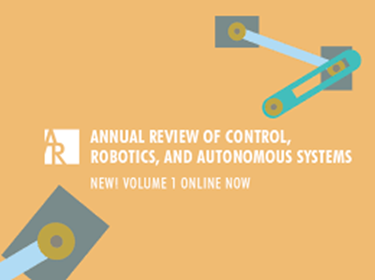Control Co-Design of Wind Turbines
IF 14
1区 计算机科学
Q1 AUTOMATION & CONTROL SYSTEMS
Annual Review of Control Robotics and Autonomous Systems
Pub Date : 2023-11-14
DOI:10.1146/annurev-control-061423-101708
引用次数: 0
Abstract
Wind energy is recognized worldwide as cost-effective and environmentally friendly, and it is among the fastest-growing sources of electrical energy. To further decrease the cost of wind energy, wind turbines are being designed at ever-larger scales. To expand the deployment of wind energy, wind turbines are also being designed on floating platforms for placement in deep-water locations offshore. Both larger-scale and floating wind turbines pose challenges because of their greater structural loads and deflections. Complex, large-scale systems such as modern wind turbines increasingly require a control co-design approach, whereby the system design and control design are performed in a more integrated fashion. This article reviews recent developments in control co-design of wind turbines. We provide an overview of wind turbine design objectives and constraints, issues in the design of key wind turbine components, modeling of the wind turbine and environment, and controller coupling issues. Wind turbine control functions and the integration of control design in co-design are detailed with a focus on co-design compatible control approaches. Expected final online publication date for the Annual Review of Control, Robotics, and Autonomous Systems, Volume 7 is May 2024. Please see http://www.annualreviews.org/page/journal/pubdates for revised estimates.风力发电机控制协同设计
风能是世界公认的具有成本效益和环境友好性的能源,是发展最快的电力能源之一。为了进一步降低风能的成本,风力涡轮机的设计规模越来越大。为了扩大风能的部署,风力涡轮机也被设计在浮动平台上,以便放置在海上的深水位置。大型风力涡轮机和浮动风力涡轮机都面临挑战,因为它们的结构载荷和挠度更大。复杂的大型系统,如现代风力涡轮机,越来越需要控制协同设计方法,即系统设计和控制设计以更加集成的方式进行。本文综述了风力发电机组控制协同设计的最新进展。我们概述了风力涡轮机的设计目标和约束,关键风力涡轮机部件的设计问题,风力涡轮机和环境的建模,以及控制器耦合问题。详细介绍了风力发电机的控制功能和控制设计在协同设计中的集成,重点介绍了协同设计兼容的控制方法。预计《控制、机器人和自主系统年度评论》第七卷的最终在线出版日期是2024年5月。修订后的估计数请参阅http://www.annualreviews.org/page/journal/pubdates。
本文章由计算机程序翻译,如有差异,请以英文原文为准。
求助全文
约1分钟内获得全文
求助全文
来源期刊
CiteScore
28.30
自引率
2.20%
发文量
25
期刊介绍:
The Annual Review of Control, Robotics, and Autonomous Systems offers comprehensive reviews on theoretical and applied developments influencing autonomous and semiautonomous systems engineering. Major areas covered include control, robotics, mechanics, optimization, communication, information theory, machine learning, computing, and signal processing. The journal extends its reach beyond engineering to intersect with fields like biology, neuroscience, and human behavioral sciences. The current volume has transitioned to open access through the Subscribe to Open program, with all articles published under a CC BY license.

 求助内容:
求助内容: 应助结果提醒方式:
应助结果提醒方式:


